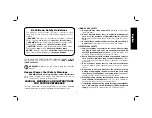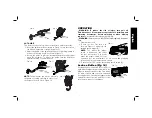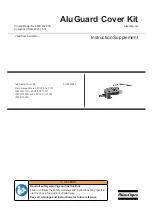
5) SERVICE
a)
Have your power tool serviced by a qualified repair
person using only identical replacement parts.
This will
ensure that the safety of the power tool is maintained.
Additional Safety Rules for Oscillating
Multi-Tool
•
Hold power tool by insulated gripping surfaces when
performing an operation where the cutting tool may
contact hidden wiring or its own cord.
Contact with a "live"
wire will make exposed metal parts of the tool "live" and shock the
operator.
•
Use clamps or another practical way to secure and support
the workpiece to a stable platform.
Holding the work by hand
or against your body leaves it unstable and may lead to loss of
control.
•
Air vents often cover moving parts and should be avoided.
Loose clothes, jewelry or long hair can be caught in moving parts.
•
An extension cord must have adequate wire size (AWG
or American Wire Gauge) for safety.
The smaller the gauge
number of the wire, the greater the capacity of the cable, that is
16 gauge has more capacity than 18 gauge. An undersized cord
will cause a drop in line voltage resulting in loss of power and
overheating. When using more than one extension to make up the
total length, be sure each individual extension contains at least the
minimum wire size. The following table shows the correct size to
use depending on cord length and nameplate ampere rating. If in
doubt, use the next heavier gauge. The smaller the gauge number,
the heavier the cord.
Minimum Gauge for Cord Sets
Ampere
Rating
Volts
Total Length of Cord
in Feet (meters)
120 V
25
(7.6)
50
(15.2)
100
(30.5)
150
(45.7)
240 V
50
(15.2)
100
(30.5)
200
(61.0)
300
(91.4)
More
Than
Not
More
Than
AWG
0
6
18
16
16
14
6
10
18
16
14
12
10
12
16
16
14
12
12
16
14
12
Not Recommended
WARNING: ALWAYS
use safety glasses. Everyday eyeglasses are
NOT safety glasses. Also use face or dust mask if cutting operation is
dusty. ALWAYS WEAR CERTIFIED SAFETY EQUIPMENT:
• ANSI Z87.1 eye protection (CAN/CSA Z94.3),
• ANSI S12.6 (S3.19) hearing protection,
• NIOSH/OSHA/MSHA respiratory protection.
WARNING:
Some dust created by power sanding, sawing,
grinding, drilling, and other construction activities contains chemicals
known to the State of California to cause cancer, birth defects or other
reproductive harm. Some examples of these chemicals are:
• lead from lead-based paints,
•
crystalline silica from bricks and cement and other masonry
products, and
• arsenic and chromium from chemically-treated lumber.
English
3




























